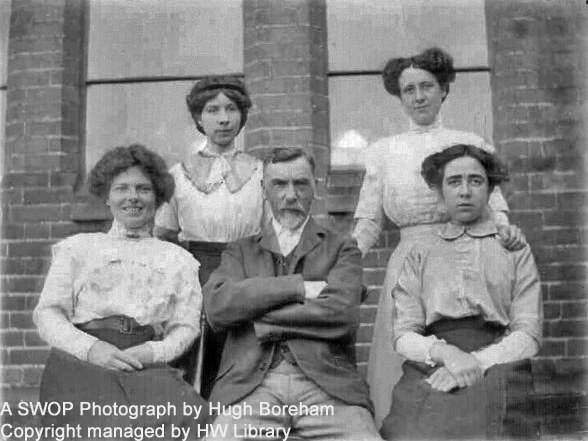How Downley Bred Strong Women
In my ongoing efforts to interpret the late-nineteenth-century census returns for West Wycombe Enumeration District 10 (i.e. Downley, Plomer Hill, Plomer Green, and Littleworth), the one thing that has struck me – apart from the focus on chairs, chairs and more chairs– is just how strong Downley women must have been.
I wasn’t expecting to find female bosses, for example, but they existed. Invariably widowed, they just took over their late husbands’ businesses and ran with them. In the almost illegible 1871 census, Mary Collins, aged 47, has taken over her late husband’s chair business: she is listed as head of the household with two lodgers (she and her late husband never had children), and a ‘chairmaker’s wife [widow] employing 20 men’. In the 1881 census, she is a ‘chair polisher employing 27 hands’ and living in Plomer Green. (Incidentally, Mary had an endearing habit of being rather vague about her age – she was probably 17 when she married but claimed to be 20, and then always subtracted a year or three off her age in later censuses) Then there’s Mary Ann Spriggs who ran Plomer Green Farm (84 acres) for thirteen years from 1887 until she died in 1900, employing two sons and two boys, and heading a household of eight.
The case of Susannah Bristow is a different essay in the strength of Downley women: making ends meet as a single mother. Her life cannot have been easy: she was twice married (to chairmakers) and twice widowed before she was 38. She raised two children, took in lodgers, and opened a grocery store on the Common, which she ran for 30 years. Another widow, Elizabeth Hopkins, ran one of the Downley pubs, while raising her two children and an orphaned nephew. Mary Austin, widowed in her 30s with two children, sewed shirts. Others became laundresses or made lace. Retirement was clearly not an option – Eliza King and Sarah West, both widows and heads of their respective households, were still taking in laundry when they were 69. Elisa Jones, a widow living alone on Downley Common, was making lace when she was 72.
Unsurprisingly, Downley women were far more likely to be self-employed than Downley men: working from home enabled the multi-tasking needed with keeping house or raising a family. On the latter subject, Eliza Avery of Littleworth wins the prize for the largest family: she raised eleven children in a house with four rooms and, presumably, an outside privy, no water on tap, and certainly no electricity or central heating. Her husband Harry was a farm labourer, which was not well paid. The challenges involved may explain why Eliza kept her eldest daughter at home, which introduces another category of equally strong – and equally invisible – Downley women (though girls in this case), the ones that we would now call ‘young carers’. In 1891, eleven local girls aged 11 to 17 were unusually in neither school nor employment. I suspect they looked after younger siblings, as Ann Avery (aged 16), Ada Collins (aged 13) and Lizzie Sherwin (aged 12) probably did, or even ran the house entirely as Annie Collins (aged 17) must have done for her widowed father and five younger siblings.
The absence from school of these girls is so noticeable because one really striking aspect of the 1891 census return is how many girls (29) as opposed to boys (10) were still in school after the leaving age, then 10. Downley girls, it would seem, were more educated than Downley boys. Mrs Ada McClean, aged 28 and lodging with the Martin family (who ran a pub on Downley Common, though which I do not know), was a school teacher, and Alice Hawes of Chapel Street, aged 15, was a pupil teacher. Alice B Mountjoy, aged 19 and living with her wealthy widowed aunt in Downley, was a ‘student at college’ and later became a teacher in London, like her mother. Four Downley girls (Clara Plumridge of Philips Cottage, Maria Gladys Martin of the Post Office, Clara Britnell of the Common, and Lily Ing of Plomer Hill) attended the newly established Wycombe High School (founded in 1901, and then the High School in Frogmore, costing two guineas a term, payable in advance). The High School then doubled as the Wycombe Pupil Teacher Centre, a training centre for elementary school teachers, and three of these four Downley girls became teachers.

Why all this emphasis on girls’ education compared to the boys? It would be nice to think that strong mothers demanded better for their daughters. The answer, sadly, is probably more prosaic: apprenticeships in the chair industry were open to boys not girls. Still, the result was a positive one – educated girls become strong women.
And if anyone should doubt the strength of Downley women, think of this: the 1872 lockout of his caners by Henry Collins that went on to convulse High Wycombe’s chair factories in an industrial crisis must have involved Downley women demanding better pay and conditions. Thirty of the thirty-one caners in Downley in the 1871 census were women.
